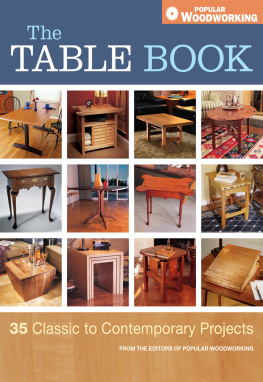The University of Chicago Press, Chicago 60637
The University of Chicago Press, Ltd., London
1992 by The University of Chicago
All rights reserved. Published 1992
Paperback edition 1994
Printed in the United States of America
08 07
7 8 9 10
ISBN-13: 978-0-226-41356-3 (e-book)
ISBN: 0-226-17030-6 (cloth)
ISBN: 0-226-17031-4 (paperback)
Library of Congress Cataloging-in-Publication Data
Duneier, Mitchell.
Slims table: race, respectability, and masculinity / Mitchell Duneier.
p. cm.
Includes bibliographical references and index.
1. Afro-American menIllinoisChicago Attitudes. 2. Afro-American menIllinoisChicagoPsychology. 3. Chicago (Ill.)Ethnic relations. I. Title.
F548.9.N4D86 1992
305.36'896073077311dc20
91-45637
CIP

The paper used in this publication meets the minimum requirements of the American National Standard for Information SciencesPermanence of Paper for Printed Library Materials, ANSI Z39.48-1992.
CHAPTER 1
Slim and Bart
They both came of age at the height of segregation. Sixty-five, a lifelong Chicagoan, Slim is a black mechanic in a back-alley garage in the ghetto. Bart, white, and ten years older, is a retired file clerk who grew up in the rural South. Both are regular patrons of the Valois See Your Food cafeteria.
I first met Bart during my early days as a university student, long before I ever set foot inside Valois. Like many older residents of the Hyde Park neighborhood, he ate regularly in the cafeteria of International House, or I-House, as it was called, a dormitory for graduate students close to the University of Chicago campus.
Tall and skeletal in his mid-seventies, Bart dressed in fine suits and sported a Dobbs hat. Sometimes when hed be sitting alone at one of the cafeterias long wooden tables, Id join him and ask about his past. He did not have any strong family ties. His only brother lived in Colorado, and he hadnt seen him in about five years. They spoke on the telephone no more than once a year. He had retired from a long career as a clerk at Swifts, one of the major meat-packing companies, during the era when Chicago was still hog butcher for the world. Then he took a job as a file clerk at one of Chicagos largest law firms.
Bart moved to Hyde Park in 1928 to attend the University of Chicago as a premedical student and supported himself for a time by working at the Streets of Paris section of the 1933 Century of Progress Exposition. He had little to say about that experience. He had been a ticket collector at the entrance to the shows but had never gone inside to look.
Bart was a very incurious person, one of many odd human beings who become attached to a university community as students and continue the association for decades. His explanation for not marrying was that some people just never find a person to jive with. His biggest dream had been to become a physician like his father, but the hardships of the Depression made it impossible for him to continue his studies.
He wasnt bitter about his life. The only resentment he ever displayed was toward blacks in the local community. With the southern drawl of the Kentucky town in which he had been raised, he often complained that Hyde Park had long ago turned into a high-class slum.
Because I thought about Bart only when I saw him sitting in his chair after dinner at I-House, many weeks may have gone by before I realized that the old man had been absent for some time. I wondered if he had taken ill. Months passed with no sign of him. I asked the front desk clerk and other residents if they had seen Bart. No one had, and I finally decided that he might have died.
Two years later, when I entered Valois Cafeteria for the first time, I was startled to see Bart sitting by himself eating a bowl of radishes, amidst black men sipping coffee at the surrounding tables. On a chair next to him was the same Dobbs hat I had seen him wearing before he abandoned I-House. He asked me how I had been and inquired about some of the people he remembered from the dormitory cafeteria. He told me that although he had liked being around the students, prices there were high and the quality of food very poor. He had been eating at Valois for a year. I asked what he could tell me about the restaurant, which is known locally by its motto See Your Food.
I dont know anything about the place.
But you eat here every day?
Yes, but I dont pay any attention to the place. I just eat my meal and go home.
As our conversation came to a close, he informed me that I might direct my questions about Valois to the owner.
Over the weeks and months that followed, I would see Bart constantly. Despite his claims, he seemed to be well aware of the other habitual patrons of the restaurant, including the group of black regulars that congregated at Slims table.
I came to learn that Slims table has, for over a decade, been the meeting place of a group of black men who regularly patronize this cafeteria on the margin of the ghetto. Slim, who comes to the restaurant every day is usually joined by Harold, a self-employed exterminator; Cornelius, a retired meter inspector; Ted, a film developer for Playboy Magazine who received an honorable discharge from the army after twenty years of service; and Earl, an administrator at the Chicago Board of Education. These and others constitute a core group that frequents the restaurant daily. Besides them, hundreds of other black men frequent Valois less often, some only on weekends. Ties binding members of the larger collectivity have developed over decades, and it is not uncommon for someone entering the restaurant to be playfully scolded by Slim or his buddies: Now, dont you go hiding from us again or Come by and see us more often, if he has been absent for any significant amount of time.
The spectrum of social classes among the black men is very broad. At one end of the spectrum are a few men like Earl from the Board of Education, middle class and college educated. In the middle, most of the men are solidly working class. At the other end of the spectrum are a significant number who have been downwardly mobile in their later years and have incomes which would place them among the working poor. These are individuals whose wages would place them at or below the poverty line.the men live in small apartments in Hyde Park or local ghettos, but some like Slim own small homes. By the standards of mainstream American society, none of these men are members of the underclass or undeserving poor, though they are sometimes treated as such by whites from the nearby university.
These black men were very much aware of Bart. Sometimes they would refer to him as the gentleman because he wore a Dobbs hat and a suit and tie. And then, after another year had passed and they had come to regard his eccentricities with affection, as Bartie. Although Bart seemed to want to remain detached from the blacks around him, he had a neighborly, jocular relationship with them. He found himself inextricably drawn into the social life at Valois as the men began to greet him cordially:









 The paper used in this publication meets the minimum requirements of the American National Standard for Information SciencesPermanence of Paper for Printed Library Materials, ANSI Z39.48-1992.
The paper used in this publication meets the minimum requirements of the American National Standard for Information SciencesPermanence of Paper for Printed Library Materials, ANSI Z39.48-1992.
